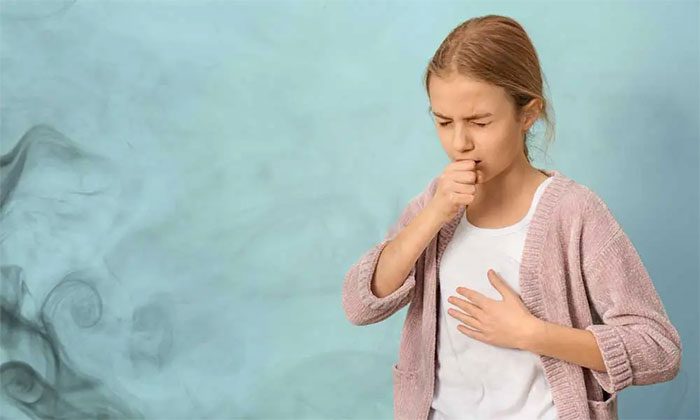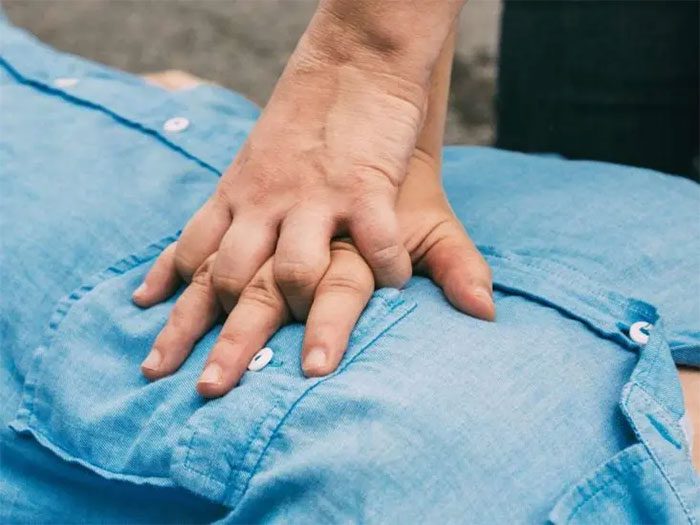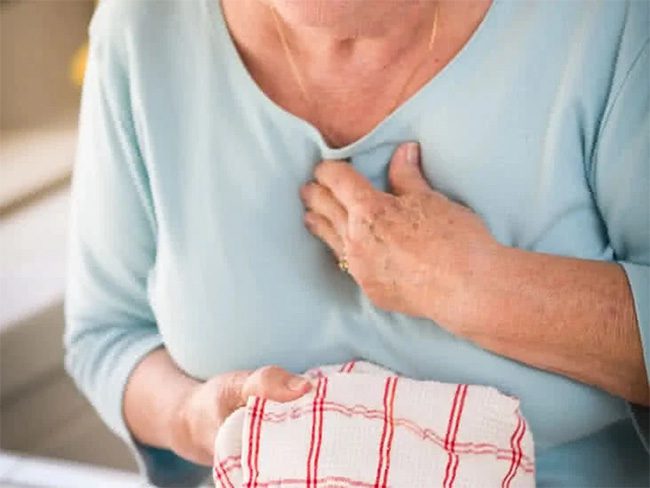In addition to the risk of burns and injuries from fires, the risk of smoke inhalation from a fire is very high. Recently, there have been a series of apartment fires that require residents to equip themselves with proper fire emergency first aid skills.
First Aid Guide for Smoke Inhalation Victims
According to Healthline, one of the leading causes of death related to fires is due to inhalation of toxic smoke which can cause pneumonia, swelling of the airways, and prevent oxygen from reaching the lungs leading to respiratory failure.
For those caught in a fire, the most critical principle for survival is to find an escape route while covering the nose and mouth with thick, damp cloths to minimize smoke inhalation for a short time to escape the fire.
To provide first aid to someone suffering from smoke inhalation, you need to keep the following information in mind:
1. Symptoms of Smoke Inhalation
Inhaling smoke can cause a variety of signs and symptoms with varying degrees of severity:
– Coughing:
- The mucous membranes in the respiratory tract produce more mucus since smoke is an irritant.
- Increased mucus production and bronchoconstriction lead to a coughing reflex.
- The mucus may appear clear, gray, or black depending on the amount of particles burned in the trachea or lungs.
– Shortness of Breath
- Damage to the airways reduces the oxygen supply to the blood.
- Inhaling smoke can obstruct the blood’s ability to transport oxygen.
- Rapid or labored breathing may occur as the body attempts to compensate for the lack of oxygen.

Coughing and shortness of breath are common signs of smoke inhalation. (Photo: Internet).
– Headache
- Exposure to carbon monoxide (CO2), a compound produced in all fires, can cause headaches.
- In addition to headaches, CO2 poisoning can cause nausea and vomiting.
– Hoarseness
- Chemicals produced from the fire, such as ammonia, sulfur dioxide, and carbon monoxide, can damage the respiratory tract, causing swelling and constriction of the airways, leading to hoarseness and upper airway spasms.
- Mucus buildup in the upper respiratory tract can also lead to airway obstruction, resulting in hoarseness and wheezing.
– Skin Issues
- The skin may become pale and bluish due to lack of oxygen or turn red due to carbon monoxide poisoning.
- Skin burns can vary in severity depending on the duration of exposure to the fire.
– Eye Damage
- Smoke from the fire can irritate the eyes or cause redness.
- In more severe cases, the cornea may suffer burns.
– Decreased Alertness, Confusion, Fainting
This occurs due to low oxygen levels in the blood and chemical suffocation from smoke affecting the nervous system; seizures and coma may also occur after inhaling smoke from the fire.

Soot inhaled from fires will appear in the nose and throat. (Photo: Internet).
– Soot in the Nose or Throat
Soot inhaled from fires will appear in the nose and throat; if sensitive, you may notice swelling in the nostrils and nasal passages.
– Chest Pain
- Chest pain occurs due to irritation of the airways from smoke.
- Chest tightness may result from low oxygen supply to the heart.
- Excessive coughing due to smoke inhalation can also lead to chest pain.
2. First Aid for Smoke Inhalation Victims
WARNING: Anyone suffering from smoke inhalation needs immediate first aid and should contact a hospital for emergency medical assistance, especially if the victim exhibits signs such as:
- Unconsciousness
- Dizziness, confusion
- Chest pain or tightness
- Difficulty breathing, severe coughing, wheezing, irregular or short breaths
- Soot and smoke around the nose and mouth
- Burns in the mouth, throat, and nose
- Swelling in the airways
- Black or gray saliva
- Nausea and vomiting
- Hoarseness
- Blurred or double vision
- Numbness and tingling in the limbs.

Administering CPR to a smoke inhalation victim. (Photo: Internet).
Here are the steps you need to take to provide first aid for smoke inhalation victims:
- 1. Move the person to a safe, well-ventilated area away from the fire. Then place the victim on their side rather than on their back to prevent choking in case they vomit or cough up phlegm.
- 2. If the victim stops breathing but has a pulse, perform artificial respiration and then call for help, continuing to provide breaths until the victim begins breathing on their own or help arrives. You can use a clean cloth or gauze to cover the victim’s mouth during artificial respiration.
According to the Fire Prevention and Fighting Police Department, artificial respiration should be performed as follows:
Method 1: Mouth-to-Mouth Resuscitation
The rescuer kneels beside the victim’s head or stands if the victim is on a bed, ensuring the victim is lying on their back. Remove any foreign objects from the mouth, including broken dentures.
One hand of the rescuer is placed on the victim’s forehead, pushing it back, while the other hand lifts the chin up so that the head is tilted back and the neck is extended as much as possible; alternatively, the rescuer may support the victim’s neck with one hand and push down on the forehead with the other hand. The victim’s head should always be kept in this position during resuscitation.
The rescuer uses their thumb and index finger to pinch the victim’s nose, takes a deep breath, and seals their mouth over the victim’s mouth tightly (if the victim is a child, seal your mouth over both the child’s mouth and nose), blowing forcefully for 1-2 seconds until the chest rises.
Repeat the process at a rate of 10 to 12 times per minute for adults; 20 times per minute for children (ages 1 to 8); and breathe quickly and lightly at a rate of 30 times per minute for infants and newborns until the victim breathes on their own.
When the victim starts to breathe on their own, place them in the recovery position.
Note: If the victim’s chest does not rise during breaths, check for airway obstruction: Is the head tilted back enough? Is the mouth sealed against the victim’s lips? Is the victim’s nose pinched closed? Is the victim’s tongue not falling back into the throat?
Method 2: Mouth-to-Nose Resuscitation
If the victim’s mouth cannot be opened or there are serious injuries preventing a seal, or in cases of drowning, mouth-to-nose resuscitation should be used.
In this case, the victim should be lying on their back. One hand of the rescuer supports the victim’s head tilted back, while the other hand supports the chin upwards to ensure the victim’s lips are sealed (to prevent blood from entering the lungs).
The rescuer takes a deep breath and seals their lips around the victim’s nose, blowing steadily until the victim’s chest rises. Continue this for four breaths.
Then remove your mouth from the victim’s nose and check if the victim is breathing on their own. If not, reassess the position and continue breathing at a rate of 10 to 12 times per minute for adults; 20 times per minute for children (ages 1 to 8); and breathe quickly and lightly at a rate of 30 times per minute for infants and newborns.
Note: In cases where the victim has stopped breathing and their pulse has also stopped, simultaneous artificial respiration and chest compressions must be performed.
The procedure for performing chest compressions is as follows:
+ Place the victim on their back on a flat, hard surface, kneel beside their chest. Locate the compression point: Find the xiphoid process (where the ribs meet), place two fingers on the xiphoid, then place your hands above those fingers.
+ Interlock your fingers and place your hands on top of each other; keep your arms straight, maintaining a stable position between your shoulders and hands.
+ Use your body weight to push straight down on the sternum, ensuring the sternum sinks 4-5 cm towards the spine, continuously at a rhythm of 80-100 compressions per minute (counting aloud to maintain a consistent rhythm).
+ If the victim is a child, the rescuer uses one heel of their hand to perform compressions, pushing down about 2.5-3.7 cm, continuously at a rhythm of 100 compressions per minute.
+ If the victim is an infant, the rescuer places two fingers on the sternum, below the imaginary line between the nipples, or encircles the infant’s chest with both hands with thumbs placed side by side on the sternum and below the imaginary line between the nipples, pushing down about 1.5-2.5 cm, continuously at a rhythm of 100-120 compressions per minute.
If the victim begins to breathe on their own, stop providing breaths; if the heart is functioning again, stop compressions. If recovery has not occurred, continue the above cycles of care until the victim recovers or until medical help arrives.
3. Quickly transport the victim to the nearest medical facility for immediate examination, even if they do not show symptoms, as serious injuries from inhaling smoke from a fire may not manifest for several hours but can worsen rapidly.
At the hospital, doctors will assess the source of the smoke inhaled, the duration of exposure, and the amount of smoke inhaled, along with several other tests such as X-rays to check for lung damage and infection; blood tests to check the levels of red blood cells, white blood cells, platelets, and how the chemical composition has affected oxygen levels; bronchoscopy to examine the airways for damage;…
4. Hospital monitoring will depend on the case as directed by the physician.
Treatment for smoke inhalation in the hospital may include oxygen therapy, bronchodilators, antibiotics to treat infections, and medications for chemical smoke inhalation…
Upon discharge, individuals who have suffered from smoke inhalation need to follow the doctor’s instructions, rest adequately; sleep on their side or propped up on pillows to facilitate easier breathing; avoid smoking and secondhand smoke; steer clear of irritants that may exacerbate lung irritation, such as excessively cold, hot, humid, or dry air, and remember to perform breathing exercises as directed by the physician for a quicker recovery.

Avoid irritants that may increase lung irritation, such as excessively cold, hot, humid, or dry air. (Photo: Internet).
3. How long does it take to recover from smoke inhalation?
The recovery process after inhaling smoke varies from person to person, depending on the severity of the exposure and the victim’s condition before inhaling smoke from a fire. Your lungs will need time to fully recover.
This means you may experience shortness of breath and fatigue for some time after being discharged. Some individuals may even face complications such as scarring that leads to lifelong breathing difficulties or hoarseness…
4. How to prevent inhaling toxic smoke during a fire
If a fire occurs, to minimize the amount of smoke inhaled, you should:
- Try to stay calm and contact firefighting services at 114 as quickly as possible.
- Quickly move to the balcony or rooftop to seek help, and don’t forget to assess the source of the fire to navigate appropriately.
- Drop to your knees and elbows to stay low to the ground, as smoke rises and is typically less concentrated near the floor.
- Use a damp cloth or clothing to cover your nose and mouth to prevent inhaling smoke and toxic gases produced by the fire.
- If trapped in a room, use wet items like towels to seal gaps to block smoke and toxic gases from entering.
In addition to the risk of smoke inhalation, fire victims may also suffer burns that can lead to serious injuries. If your clothing catches fire, roll on the ground until the flames are extinguished.
The above information provides first aid for individuals suffering from smoke inhalation during a fire. Those administering first aid must remain calm and contact the nearest medical facility for timely rescue of the victims.



















































